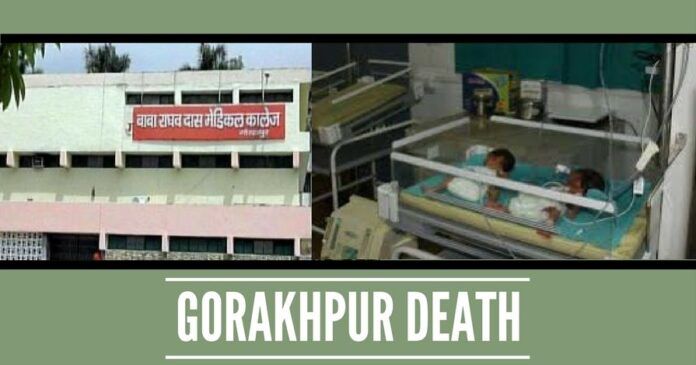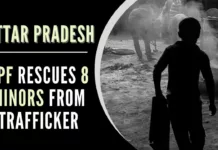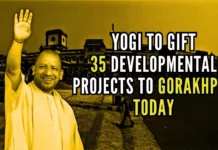
The Central Government needs to work in the health sector to realize the dream of making India a developed country.
As the nation celebrates its 70th Independence Day, bereaved families in Gorakhpur grappled with the deaths of their children. Around 70 children, including neonates, died in one week in the pediatric ward of Baba Raghav Das Medical College (BRD Medical College) in Gorakhpur. The cause was believed to be encephalitis.
Amidst allegations and contradictory reports, the truth gets buried even further. The sound bytes of “netas” on television screens cross the permissible decibel limits by several notches and continue to befuddle the nation, while the techno-savvy ones take to social media to speak, rant and scribble all over the cyber boards, giving their version of the tragedy. The Gorakhpur tragedy, with deaths of more than 70 children since August 7 has opened up a can of worms, but that is hardly surprising. The aftermath of every tragedy is marked by political jargon and brickbats full of sound and fury signifying nothing. So why should this be an exception? Most of these rabble-rousers, unfortunately, are ill-educated about the health system in India and the hierarchy of administration or they are purposefully masquerading ignorance to gain political mileage.
In three days, during which more than 30 children died at the hospital, the parents of dead babies alleged that the deaths occurred due to the shortage of oxygen, although the state administration denied it initially. The spread of the news of the deaths and other incidental occurrences made people point an accusing finger at the oxygen supplier. The provider of oxygen cylinders had been writing to the hospital authorities for quite some time to settle its dues. The contents of some of these letters had also been leaked to the media, showing that the provider had threatened to stop the supply if his dues of Rupees 60 lakhs were not paid immediately.
The provider of oxygen cylinders had been writing to the hospital authorities for quite some time to settle its dues.
With the Opposition mounting pressure on CM Yogi, the state government decided to act fast and suspended the physician in charge of the ward that recorded the most deaths. They also removed the BRD Medical College Principal. Incidentally, it was this physician who suddenly fell from grace after being labelled as a ‘hero’ a day earlier when he arranged to procure oxygen cylinders from nearby hospitals by driving around the city. It is ironic that the person who did this was held negligent for severe dereliction of duty after it was reported to him that the hospital had only a few hours of oxygen left. Any administrator will tell you such genuflection to procuring life protecting supplies at the 11th hour is a sign of severe failure at many different levels. Such “heroism” if it did happen, was for self-preservation, rather than selfless service to humanity. Furthermore, that the same physician, in simultaneously running a private practice in addition to his government job, demonstrates a conflict of interest that doctors should avoid in all cases. However, since an inquiry has been ordered, it is expected that the truth will come out. The same physician was arrested based on preliminary investigation and arrested.
The state government had maintained throughout that the shortage of oxygen was not the real cause of this tragedy, as encephalitis has been the leading cause of child deaths every year due to unhygienic conditions in the hospital. Later the authorities, of course, admitted that the supply of oxygen had been affected for two hours. Before the scenario gets even murkier, it is important to go back to see the unfolding of events:
- On August 1, the Principal of BRD College, Dr Rajiv Mishra, forwarded the supplier’s letter mentioning the payment that was overdue.
- On August 5, the Ministry of Health released the funds.
- On August 7, funds were received in the account of BRD, and there was the acknowledgment by the hospital.
- On August 9, CM Yogi Adityanath visited the BRD Hospital to inaugurate award. At that time, the hospital authorities did not apprise him of this shortage. This action could have at least prevented some deaths that were actually due to lack of oxygen.
Encephalitis has been claiming hundreds of lives in the state every year.
Earlier on the same day in Allahabad, Adityanath had mentioned the encephalitis cases in BRD Hospital and said that the passing of these children was caused by filth and the scourge of open defecation and that the disease has been recurring in eastern Uttar Pradesh since 1978.
A look at the health scenario of the state would help one in understanding the situation better. Encephalitis has been claiming hundreds of lives in the state every year. According to a report by the Directorate of National Vector Borne Diseases Control Programme, 26,686 cases of encephalitis were reported in Uttar Pradesh between 2010 and August 2017. Of these, 24,668 cases were of Acute Encephalitis Syndrome (AES) and 2,018 of Japanese Encephalitis (JE). Out of those reportedly suffering from AES, 4,093 deaths were registered and 308 JE deaths were recorded in the same period. The report gives figures till 6th of August, 2017, which shows 924 AES cases with 127 deaths and 97 JE cases with three deaths.
As far as BRD Medical College is concerned, according to a Firstpost article dated August 14, the hospital has an average of 200 deaths per bed, making Gorakhpur highly endemic to encephalitis. The present CM and former MP from Gorakhpur, Mr. Yogi was well aware of the gravity of the problem and had raised this issue in the Parliament and wanted to declare it as an epidemic during the Samajwadi regime. The previous governments, including Mayawati’s and later Yadav dynasty, did very little to change the scenario. Expecting that a chronic problem of uncleanliness, apathy toward duty by daily staff, and physicians breaking all the rules by doing private practice while being employed could be modified within 200 days of a new government is ostensibly divorced from reality.
In reply to an RTI filed by one Rahul Verma, the Department of Pediatrics report stated that from 2009 to 2011, 3,745 children had died in the hospital. Among the top five reasons of death, encephalitis tops the list. The report also revealed that the incubator, pulse oximeter and infant ventilators in the hospital were out of order during this period. These, it may be pointed out, are the core armamentarium of a pediatric ward that is mandatory to fight these diseases and save lives. Ostensibly, lack of these basic amenities has been due to inappropriate supervision by hospital authorities of the state‘s direction over them. Moreover, it is not surprising that these lacuna of necessary infrastructure are responsible for the dismal performance of the hospital.
Providing education to the public on health related issues are needed in most states in India to induce changes in the rotting system
Baba Raghav Das Medical College, which tackles encephalitis and meningitis cases every year, has a budget of just Rs 5.32 crore for medicines, according to the state budget figures. This isn’t surprising or unique. Healthcare spending is abysmal in our country, irrespective of state, and that is not a secret.
Research conducted by the medical journal Lancet shows that India ranked 154 out of 195 countries regarding health care access, far behind countries like Bangladesh, Nepal, Ghana and Liberia. India spends only 5 percent of its GDP on public healthcare. India has the highest per capita income of the 15 countries given in the chart, including countries like Nicaragua, Vietnam, Honduras, Uzbekistan, and others, but regarding healthcare spending, it is the lowest. Does this not indicate a mindset that needs to change its priorities? Healthcare is a state issue, and the individual state has to come up with plans and programs to tackle this menace, which is widespread. Some months back, at the start of Mamata Banerjee’s rule, there were reports of multiple children‘s deaths in different hospitals where the doctors were held responsible for “negligence” and many of them were physically assaulted. It is important to understand that health improvement and reducing childhood death needs more than dedicated doctors. Most physicians in the country are dedicated, and those who do indulge in erroneous activities are and should be chastised and not made into heroes. However, the state government should not shirk its responsibility in providing adequate finances, technical help and education to the public on health-related issues which are urgently needed in most states in India to induce perceivable changes in the rotting system.
the arrangement between this provider and the state government was to stop supplies when more than 10 lakh of accrued debt was owed by the government
The Gorakhpur tragedy has taken a nasty turn with the blame game in place and the real issues buried. The tragedy has become enmeshed in the political quagmire with the government taking a firm stand, saying, ‘The guilty will not be spared,‘ and the Opposition demanding moral responsibility from the BJP government and the resignation of CM Yogi. The real need is to stop genuflecting to political necessities and garner the honesty to overhaul the systems in place, including punishment from the ground up to the top brass level and not a cosmetic paint down. While the principal has resigned of his own accord on moral grounds, it is not clear what the communication between the stock keepers (read hospital supplies) at BRD and the top level was. Did it take until August 1st, almost at the 11th hour to inform the state government? Why was the CM not told during his visit? It must be delineated at what level or hierarchy of administration this decision was made. If the state released payment on the 5th, why was it not paid and mishap averted? Was hospital property, including oxygen cylinders, being trafficked to private practices? Why were environmental services through the last decade not beefed up to remove the stink and lack of hygiene at the hospital, which in fact is responsible for more death than anything else? What was the role of the accounts section in the hospital that over 60 lakhs were owed to this oxygen supplier, forcing him to cut supplies?
This significant amount must have been generated over time and maybe appropriate communication could have helped. Based on media reports, the arrangement between this provider and the state government was to stop supplies when more than 10 lakh of accrued debt was owed by the government. Most importantly, it is important to provide a clean and hygienic environment at the hospital. In essence, the need of the hour is to delineate the source of malfunction within the system and treat violations as criminal negligence. Only this will preempt the occurrence of such incidents in future. A team consisting of physicians, accountants, supply chain specialists, cleaning services, etc. needs to be set up to do a post-mortem and take remedial steps. The Central Government is not directly involved in this incident as the issue is under state control, but it needs to work in the health sector to realize the dream of making India a developed country.
Note:
1. The views expressed here are those of the author and do not necessarily represent or reflect the views of PGurus.
- ModiCare – not enough to modify years of neglect! - April 23, 2018
- Gorakhpur Death-A Clarion Call to Change the Rotting Health System - September 22, 2017
- Paradise lost to violent radicals – Basirhat: a case in point - July 11, 2017










